Sci-Ed Update 347
Sexing a skeleton, anatomist dishonor, teaching evaluations, too fast to see, boys that don't grow a penis until 12, super-vision IR contact lenses
New Contact Lenses Give Users Super-Vision to See Infrared Light—Even With Their Eyes Closed

Within the spectrum of electromagnetic radiation that reaches Earth, humans are only able to see a narrow range of wavelengths, called visible light. Now, however, a team of neuroscientists and materials scientists has created contact lenses that allow users to see the longer wavelengths of infrared light—and they’ll even work when people have their eyes closed.
The team described their research in a study published last week in the journal Cell.
While night vision goggles, with which one can also see infrared light, have been around for a long time, these contact lenses boast a few key advancements. For one, they don’t need a power source, and they also enable users to see a number of different infrared wavelengths. Participants could also see visible light alongside the infrared, since the lenses are transparent, according to a statement from the journal.
In human trials, participants detected the presence and direction of flashing infrared light. Furthermore, the researchers “found that when the subject closes their eyes, they’re even better able to receive this flickering information, because near-infrared light penetrates the eyelid more effectively than visible light, so there is less interference from visible light,” Tian Xue, senior author of the study and a neuroscientist at the University of Science and Technology of China, says in the statement.
Read more→ AandP.info/4101b3
In This Remote Village, Some Boys Don't Grow a Penis Until They're 12
Puberty can be an awkward time for anybody, but spare a thought for the Guevedoce children of the Dominican Republic, who literally appear to change their sex when they hit adolescence.
As covered by Michael Mosley in the 2015 BBC series, Countdown to Life: The Extraordinary Making of You, the remarkable case of the Guevedoces is a condition that affects just over 1 percent of the boys born in Salinas, a remote village lying in the southwest of the Dominican Republic.
Guevedoces (literal translation "penis at 12") - who are also called "machihembras", meaning "first a woman, then a man" - appear to be completely female at birth and are brought up to be little girls.
"When they're born, they look like girls with no testes and what appears to be a vagina," wrote Mosley for The Telegraph back in 2015. "It is only when they near puberty that the penis grows and testicles descend."
After the developments of puberty, Guevedoces grow up to be fully functional males in their society, although some telltale signs do give away their unique biological heritage.
Read more→ AandP.info/9c5ed1
How Fast Is Too Fast to See? Study Reveals Your Visual Speed Limit

When a camera whips around from one point to another, most people expect the fast movement to result in a blurry smear. What they don’t realize, however, is that our own eyes engage in a similar kind of rapid movement—called saccades—over 100,000 times a day. Unlike video cameras, our brain avoids the nauseating blur—but when things move in a particular way, they become invisible.
As detailed in a study published May 8 in Nature Communications, researchers have revealed that the speed of an individual’s saccades corresponds to the limit at which a moving object becomes too fast for them to see. That means people with faster eye movements can perceive faster-moving objects, with potential implications for activities requiring fast eye movements such as sports, video games, and even photography. The researchers claim to be the first to provide evidence for the theory that a person’s movement impacts their perception.
Read more→ AandP.info/fc6236
Teaching evaluations shook my confidence—until I learned to filter the critiques
It’s my least favorite time of the year: a few weeks after class ends, when I read anonymous online evaluations of my teaching—and, seemingly, everything about me as a person. One student calls my tone of voice “sarcastic and condescending” while another complains I’m “too positive and enthusiastic.” I’ve been judged for my clothing choices—“too casual” if I wear jeans and a sweater, “unnecessarily intimidating” if I wear business attire. Some students have faulted me for assigning too much work, whereas others claim I don’t assign enough for them to learn anything. Even my facial expressions aren’t safe—one evaluation said I didn’t smile enough, another accused me of being “too happy and cheerful.” It takes its toll. But I have come to realize that no matter how hard I try or how much I care, I won’t be universally liked—and that’s OK.
Read more→ AandP.info/013bfb
Student Evaluations of Teaching I: The Good, The Bad, and The Ugly
Student evaluations of teaching (SETs) are problematic in many ways—but perhaps useful in other ways. Host Kevin Patton discusses the good, the bad, and the ugly. What are the issues and what’s behind those issues?
Student Evaluations of Teaching II: Proactive, Active, and Reactive Strategies
Host Kevin Patton continues the discussion about student evaluations of teaching (SETs) with a set of strategies to make them work better, or at least mitigate some of the potentially bad or ugly outcomes. There are things we can do proactively before a SET, actively during a SET, and reactively after a SET. Listen to hear them all!
To listen to these episodes, click on each play button above ⏵ (if present) or use these links→ (1) theAPprofessor.org/podcast-episode-84.html and (2) theAPprofessor.org/podcast-episode-85.html
WashU to strip anatomy leader’s name from honors over ties to eugenics, human remains collection
Washington University in St. Louis will remove the name of a former anatomy department leader from all university honors and features following an ethics review that cited his promotion of eugenics and nonconsensual collection of human remains.
The university announced plans Friday to remove the name of Robert J. Terry, MD, from campus branding, including the Robert J. Terry Lecture Series and the Robert J. Terry Professorship at the School of Medicine.
Terry, who died in 1966, was once the leader of the anatomy department at WashU Medicine, the university’s medical school.
Read more→ AandP.info/736843
How do archaeologists figure out the sex of a skeleton?
When archaeologists find ancient human remains, they often try to determine if the person was male or female based on their bones.
So how do archaeologists figure out the sex of the individual from their skeleton, and how accurate are their techniques?
Archaeologists often take measurements of long, slender bones, like the femur and tibia (which make up the leg), and then use statistical methods to predict the person's sex.
"On average, males are about 15% larger than females," Kaleigh Best, a biological anthropologist at Western Carolina University, told Live Science. But many variables — such as diet, genetics, disease and environment — go into body size, so there can be wide variation even among people of the same sex.
"Overall, we're looking at shape and size differences between the sexes," Sean Tallman, a biological anthropologist at Boston University, told Live Science, but "no one method is 100% accurate."
Kevin Patton comment→ There’s more in the linked article, of course. I just want to add that learning more about this from HAPS workshops and a course I took at Leiden University has helped me answer student questions and give a few background facts that intrigue and engage learners.
Read more→ AandP.info/a59a62








